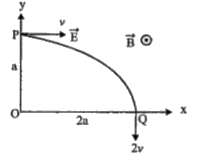Recommended Questions
- A particle with charge +q and mass m, moving under the influence of a ...
Text Solution
|
Playing Now - A particle of charge +q and mass m moving under the influence of a un...
04:17
|
Play - A particle of charge +q and mass m moving under the influence of as un...
05:13
|
Play - A particle of charge -q and mass m enters a uniform magnetic field vec...
05:12
|
Play - A particle is moving in a circle of radius r with speed v as shown in ...
06:16
|
Play - To particles P and Q are initially 40 m apart P behind Q. Particle P s...
03:09
|
Play - A positive charge particle of charge q, mass m enters into a uniform m...
04:08
|
Play - A positive charge particle of charge q, mass m enters into a uniform m...
Text Solution
|
Play - A positive charge particle of charge q, mass m enters into a uniform m...
Text Solution
|
Play
